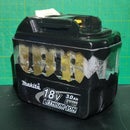Introduction: Metal Cosmoclast Helmet (Destiny: Rise of Iron)
This project began as a proof of concept for using alternative materials to fibreglass and card in order to produce a rigid structure without the risk of cracking should it happen to sustain fall damage.
Two options I considered were lightweight plastics which would allow some flex (Absorbing some of the impact) and metal. While metal would be heavier and could not be formed from single pieces without high temperatures or pressures, the only way to create a plastic helmet would be vacuum forming, which I currently don't have the tools for.
While browsing through some of the concept art and armour renders for the latest Destiny expansion, I realised that any piece of armour with a low enough polygon count could feasibly be made from metal in exactly the same way traditional pepakura armour would be made, although seams would have to be welded or riveted rather than glued.
Step 1: Creating the Template
All of Destiny's armour and weapons can be viewed online, which allows certain online tools to export the models as 3D files such as a .stl
They retain their original co-ordinates, so by exporting the helmet and boots into the same scene, you can scale them to be correct for a 6ft tall person, or any other height. It seemed that the default scaling was just under 6ft once boots and helmet height were accounted for. Also, my printer printed at around 96% the stated dimensions, so after some adjustments, I had the necessary scale factor to create a helmet that would fit well.
In Pepakura Designer, I removed all but the front and side faces for each plate of the helmet, and turned off tabs, as most bends would be stiff enough to retain their angle without the need to be riveted to adjacent sides.
Step 2: Transferring the Templates to Metal
Once printed, the templates can be stuck to a sheet of metal using general purpose glue. I only printed off one copy of any pieces that would be mirrored, so they could be reversed and used for the other sides (This meant I had to trace them out after sticking them down and remove them so as not to damage them when cutting out the metal).
1mm Aluminium sheet is the ideal choice for this, as you can cut the pieces out using metal shears. The only metal I had available was a 1mm thick sheet of steel from the side panel of a computer, so I chose to cut them out with an angle grinder (This has the benefit of not distorting the edges of the metal, though does require more effort to clean up).
To get sharp, clean bends it's necessary to score the lines where the bends are located. I used the angle grinder to remove about 0.5mm from the thickness of the metal, then clamped it in a vice and gradually moving it along while bending it to around a 90° angle.
Step 3: Joining the Segments
I used 5 strips on each side of the mask to hold the sections together, then folded 4 longer strips into a small trapezoidal prism to produce the two visible joints on each side.
Using 4 rivets on each metal strip prevents them from twisting, and reduces the chance of the rivet shearing off.
Step 4: Final Assembly
The individual sections can be lined with foam to reduce the impact of the sharp edges. An added bonus of using metal is that you can use mechanical methods such as sandpaper to simulate wear, rather than painting on the detail. At a later stage I intend to create the back of the helmet using EVA foam but wrapped in fabric rather than painting the detail on.
There are no viewing holes on the front of the mask, although the thin seams between the riveted plates of metal allow for very limited visibility. Thin slits could be added to the bends at the front to create some hidden viewing holes, although in a future update I hope to integrate a better system, such as a camera or wide angle lens.
For the time being though, it still makes a great futuristic looking hat!




